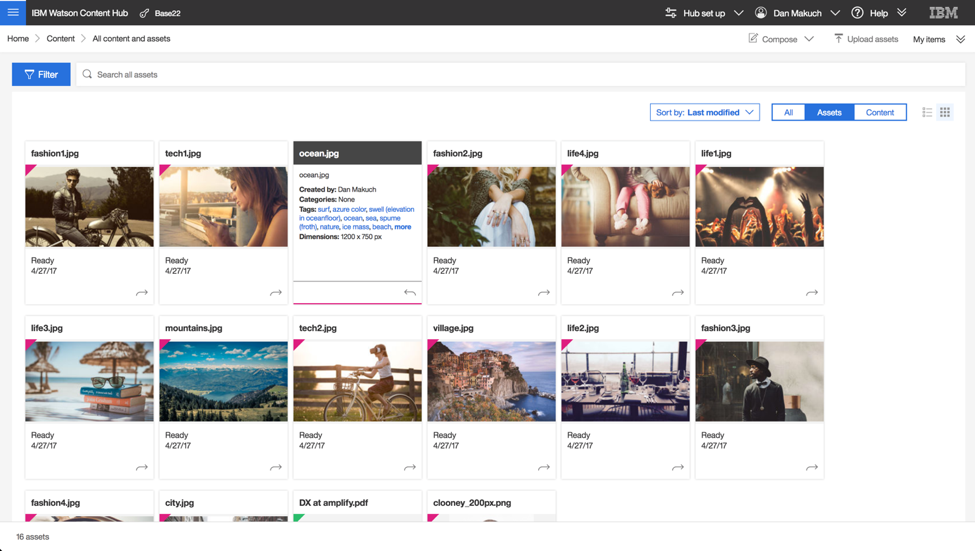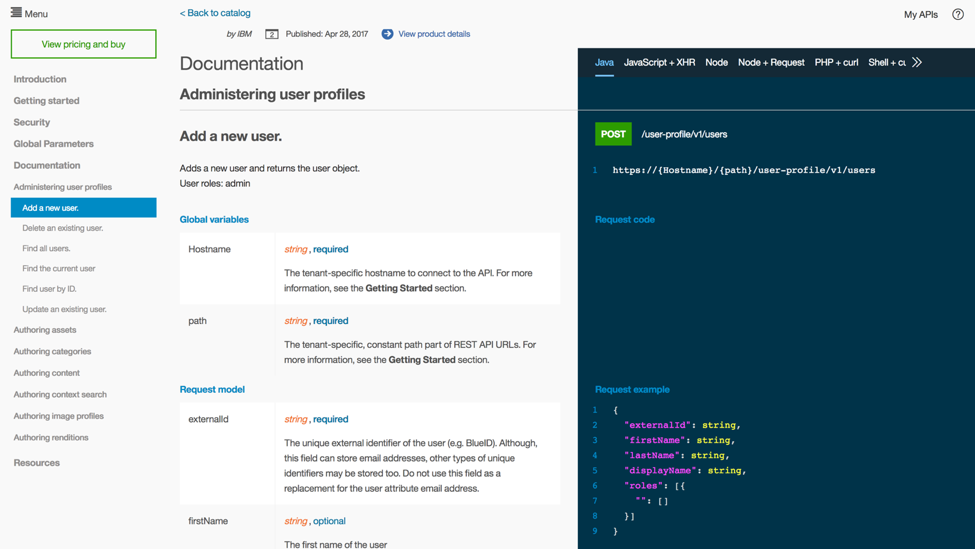Worth A Look: IBM Watson Content Hub
In mid-November of last year, IBM released a new Software as a Service (SaaS) content management offering known as IBM Watson Content Hub. Base22 participates in a design partner program with IBM and, as a part of that, we have had the opportunity to review plans and provide feedback to the product team on various aspects of this offering since prior to the initial release. As a result, we have been closely tracking the evolution of the product, and we believe that if you haven’t had an opportunity to check out this solution yet, it is definitely worth a look now.
As with any 1.0 product, the first Watson Content Hub (WCH) release consisted of a relatively limited set of capabilities to enable some core use cases and provide a foundation for future development and enhancements. However, one of the great things about the SaaS model is that it allows for rapid delivery of new features and capabilities on a monthly, weekly, or even daily basis. IBM has been taking full advantage of this model, and over the course of the past 6 months, the product has seen significant growth and advances. And much more is planned moving forward through the rest of 2017 and beyond.
What follows is not meant to be a product review. Nor is it a comprehensive description of all the product’s features and functions. Rather, it is intended to provide a high-level overview of the solution and some of the aspects that we consider most interesting. Hopefully, it will be enough to peak your curiosity and inspire you to do some additional investigation into what very well may be the future of content management from IBM.

How is WCH different than what we have seen before?
Many of you who are reading this are probably familiar with WCM, IBM’s on-premise web content management system. You may be wondering if WCH is just some sort of cloud-hosted version of that product. The answer to that is emphatical “no”. Watson Content Hub was architected and built from the ground up to be a cloud-native solution meaning that it is composed of loosely-coupled services which are designed to be multi-tenant, highly scalable, and capable of being distributed across multiple data centers.
Unlike WCM, which is focused specifically on delivering content for websites and the mobile web, WCH is designed to be more of an omnichannel CMS. This means that it can support the content needs of not just traditional websites, but also native mobile apps, standalone web applications, email marketing tools, online commerce storefronts, and anything else that requires digital content.
Another major difference is that Watson Content Hub is what is known as a “headless” CMS. The term “headless CMS” has been around for a few years now and it is used to describe a system that focusses exclusively on the creation and storage of digital content while leaving the presentation of that content to the consuming application. The CMS provides RESTful APIs to allow applications to find and retrieve whatever elements of the content they need. Typically, the content is returned in a JSON format which can be easily processed with front-end web technologies.
The main point of this is to completely decouple the content from its presentation in order to provide maximum flexibility and reuse across different channels. So, for example, the exact same image and text could be used in a carousel banner on a website, a marketing spot in an e-commerce storefront, an ad in a native iOS app, and an article in an email newsletter.
Savvy WCM developers will know that you could achieve some of these same things with the on-premise product, and here at Base22, we have done exactly that on many occasions over the past few years. However, I believe that Watson Content Hub includes several features that give it a distinct advantage for these kinds of scenarios.
Product Overview
In the simplest terms, Watson Content Hub consists of a cloud-based common content repository and a web interface for creating and managing the assets that are stored in that repository. The product also includes the Akamai content delivery network (CDN) to enable fast access to content assets from any location around the globe. Customers pay a monthly fee that starts at $250/month for up to 10 GB of storage and 100 GB/month of data transfer. They can purchase additional storage and data transfer capacity up front for a higher fixed monthly price, or on a pay as you go basis.
There are four basic constructs that make up the content model in WCH.
Assets

The term asset is used to refer to any type of file you upload into the WCH content store. The administrator for your company’s WCH instance can set limits on the maximum file size allowed for images, videos, and documents. When a file is uploaded it automatically gets pushed out the CDN so that it can be retrieved as quickly as possible anywhere in the world. Certain types of assets also get analyzed and tagged with relevant metadata (more on that later).
Content Types

Content Types are a collection of elements that define the structure of a given content item. Hub managers can create a content type and select from a variety of different field types such as Text, Date, Image, and Link to define what information a content author must provide when creating a content item of that type. For example, an Article content type might include text fields for Title, Summary, and Body plus a date field for Publish Date, an image field, and a category field to allow the author to specify the Topic(s) that the article is about. Once the content type is saved, it becomes the input form authors use to create or edit content.
Image Profiles
Image profiles allow you to define a set of renditions of an image that will be automatically generated and pushed out to the CDN when an author creates content. Each rendition represents a different height/width combination. When an author adds an image to a profile on a content item they will have the ability to adjust the crop position for each rendition. A single source image can be used by many image profiles.
Taxonomies
Customers can define their own custom taxonomies for classifying both assets and content items. Authors can apply the appropriate categories to content as it is created. Those categories can later be used to find relevant items through both the WCH management UI and the API.
It’s called Watson Content Hub so it must have some “cognitive” capabilities, right?
You bet. The solution includes the Watson Visual Recognition service which can analyze images and suggest a list of tags that correspond to the contents of the picture. These tags are automatically applied to the image when it is uploaded to the repository, but authors can choose to reject some, or all, of the suggested tags. Similar services are included to analyze documents and suggest tags that relate to the concepts found in the text. The idea is to help users find relevant content later as the repository grows. In the future, IBM plans to incorporate additional cognitive services that can help you understand which content works best in certain scenarios and make suggestions based on natural language questions and interactions.
This speaks to another difference between WCH and many traditional web content management systems. In WCH there is no concept of a manually created folder or site structure to organize the content repository. Instead, the system provides a powerful search engine based on Apache Solr. Users can search for content and assets based on a variety of different facets such as content type, Watson tags, image metadata, and more. The API can leverage this same search capability to locate and retrieve the appropriate content for a given presentation.
Programmability and Integration
And speaking of the API, no discussion of Watson Content Hub would be complete without at least briefly touching on the programmability and integration features of the product. The API is divided into two general categories: authoring services and delivery services.
As the name implies, the authoring services can be used to create, update, and delete all the various types of objects that make up the WCH content model. In addition, these APIs can be used to manage user accounts for the system. A Node JS based command line interface tool is available on Github which uses the authoring APIs to do bulk uploads and downloads of content and assets. Authentication is required to be able to use the authoring service APIs.
The delivery services, on the other hand, can be accessed anonymously. These APIs are optimized for caching and performance. They can be used to search for and retrieve content and assets for use in consuming applications.
All the API services are documented online in the Swagger format with examples of usage in various programming languages such as Java and JavaScript.

While the API covers everything you might need to integrate WCH-managed content into your own apps, IBM has also begun to deliver pre-built integrations with some of the other Watson commerce and digital marketing tools. One of the first examples of this is the integration with the Digital Experience v9 platform that was released in December 2016. DX v9 includes a new WCH portlet that provides a picker UI which allows page authors to search for and select an image or video from the WCH repository to render on the portal page. Similar types of integrations are planned for Watson Digital Commerce, Watson Real Time Personalization, and more.
Additional Resources and Next Steps
That pretty much covers the highlights. Of course, the best way to really investigate the product is to get in there and “kick the tires” for yourself. Fortunately, IBM provides a number of resources to help you do just that. The first step is to go to the IBM Marketplace and sign up for a free 30-day trial. This will give you access to all of the Watson Content Hub capabilities and the same amount of storage as the base offering.
Once you have your free trial set up, check out the Watson Content Hub Developer Center for links to code samples and blog posts that dive deeper into some of the concepts we touched on above. There were also several good presentations on WCH at the recent Amplify conference that can be downloaded from the conference website.
And finally, you can always reach out to your friends here at Base22. We’d love to hear about any ideas you might have for leveraging this solution in your business and of course we’d be happy to help in any way we can ;-).



